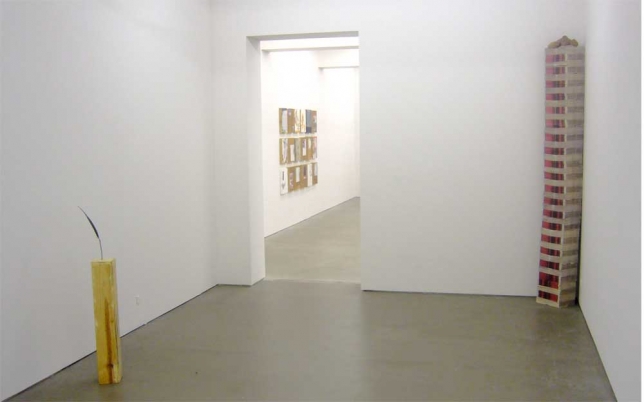2.09. - 11.10.2008
"The Fullness of Time"
Group exhibition with works by
William Cordova, Leslie Hewitt, Rashawn Griffin, Gean Moreno
Curated by Rashida Bumbray (The Kitchen, New York)
at Arndt & Partner, Zurich
 "The Fullness of Time" Group exhibition with works by William Cordova, Leslie Hewitt, Rashawn Griffin, Gean Moreno
"The Fullness of Time" Group exhibition with works by William Cordova, Leslie Hewitt, Rashawn Griffin, Gean Moreno PRESS RELEASE
Arndt & Partner opens the new exhibition season with four young US artists who represent strong individual positions within radical realism. Three of them shined forward at this year’s Whitney Biennial.
Leave it to this generation of artists – perpetually predisposed to sampling – to address the contemporary moment adequately armed with arsenals full of the tools of history. For William Cordova, Rashawn Griffin, Leslie Hewitt and Gean Moreno, the project of re-purposing the breakbeats, tags and signifiers of time has been an intense preoccupation, where the tools of their trade are purposefully chosen for their cultural and temporal relevance. Through a fluid interplay of past and present, these artists mix and match seemingly disparate elements with deliberate imperfection – initiating a call and response across time and space.
Digging into the crates, arsenals, and archives of new world history to include – first editions of Alex Haley’s Roots and Samuel Delanys The Jewels of Aptor, revolutionary newspapers, fig-newton cookies, Peruvian gourds carved with ancestral messages, scraps of worn sheets and newly bought denim, wood from the South Side of Chicago, and collapsed bookshelves among other objects with previous lives and multiple meanings, Cordova, Griffin, Hewitt and Moreno’s works grant interiority to a sophisticated critique of the now, full of coded interpretation and subversive potential.
William Cordova has developed a prodigious body of sculptures, installations and works on paper that are drawn from a continuum of radical movements and players in struggles for self-determination. Revealing the intersections between magical realism and social realism, he orchestrates collisions between ancient and recent histories, oral tradition and revolutionary texts, urban and rural landscapes to make way for an in-between, transitional, and ultimately transformative space.
Through lyrical interplay of forms, colors and unconventional materials (including food and mass produced ephemera) Rashawn Griffin creates narrative fragments, using material as expressive metaphor. His sculptural architectural forms and “paintings” emanate out of the active and evolving archive that is his studio. From overwhelming piles of clothes, rolls of fabric, tassels, jellybeans, almonds, and wood, among countless other articles, Griffin deftly blends his specific vernacular junkyard aesthetic with formalist notions of painting to interrogate identity and explore new ways of experiencing pictorial space.
Leslie Hewitt’s unique work traffics in a realm between the sculptural and the photographic. With a conceptually rigorous practice steeped in the re-purposing of mass produced objects chosen for their value in personal and public vernacular settings, she constructs her signature contemporary still lives with special attention to balance, syncopation, and repetition. Hewitt balances objects from amorphous personal archives of books, albums, and photographs within a specific interior architectural space and makes way for the piecing together and propping up of symbols of Black genius and commodity within her sophisticated visual investigation of the nuances of time, space, memory, and circumstance.
Specifically referencing new and future developments in immigrant and Third World flea and merchant markets, Gean Moreno’s interest in market culture as both functional and architectural form is echoed throughout much of his practice. The artist builds minimal wooden frames for many of his analogous sculptures that are then draped and ornamented in layers of patterned tapestry, jewelry, plastic foam, hosiery, etc. Exploring the contradictions and struggles between linear forms and the geomorphic and organic forms that populate these structures en masse, Moreno reveals a metaphor for the density of information encroaching on contemporary everyday life.
For the exhibition The Fullness of Time at Arndt & Partner, Zurich, recent works by Cordova, Griffin, Hewitt and Moreno find a hope and critique in the colliding present, past and future. When something happens in “the fullness of time,” it will happen when the time is right and appropriate.
Excerpts taken from a text by Rashida Bumbray, The Fullness of Time, in: Checkpoint #6, 2008, the gallery review of Arndt & Partner